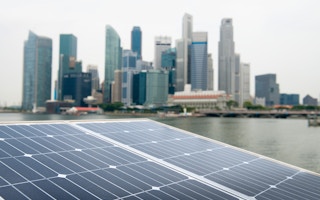Solar power users in Singapore may soon find it easier to sell their excess electricity to the national grid as the city-state moves to further integrate solar energy into its electricity infrastructure.
The Energy Market Authority on Monday launched a public consultation to review the regulatory framework for intermittent generation energy sources such as solar which will, among other issues, look into simplifying the registration process for small consumers to sell their electricity to the grid.
The paper is available on the agency’s website and the public is invited to give their views until January next year.
Minister in the Prime Minister’s Office S. Iswaran announced this in his opening remarks at the Singapore Energy Summit held at Marina Bay Sands Convention Centre to hundreds of industry delegates.
The summit is part of the annual Singapore International Energy Week, which began on Monday and convenes global thought leaders, policymakers and professionals to discuss energy issues.
He also announced that the cap for intermittent energy supply to the national grid will be raised from 350MWp to 600MWp.
The cap is put in place as energy reserves are required to back-up intermittent sources and ensure system stability.
EMA is reviewing this approach to explore how best to procure and cost in reserves, he said, but first the cap will be raised to encourage more renewable energy uses.
Speaking to reporters on the sidelines of the summit, Mr Iswaran said this was a “significant move” as it meant Singapore was committing more capacity and resources to manage the intermittency.
As the output of energy from intermittent energy sources such as solar and wind are dependent on external factors such as the weather, they have to be managed such that black-outs and power disruptions are minimized.
Managing director of Singapore-based solar systems integrator Phoenix Solar, Christophe Inglin, told Eco-Business that the latest move was good news for the industry.
“PV is already commercially attractive in Singapore today, as demonstrated by a growing number of large-scale projects in the MW (megawatt) range. The cumulative installed capacity is likely to double this year, and growth looks set to continue at a fast pace. The last thing the sector wants is for growth to come crashing to a stop if we hit a hard cap on installations any time soon,” he explained.
“
It will take some time for us to digest and understand the proposals. Provided the resulting regulatory mechanisms are fair, Singapore is likely to serve as a role model for the region, as grid parity spreads to other markets
Christophe Inglin, Phoenix Solar managing direcor
He added that EMA’s consultation paper “indicates a clear effort to correctly price both the positive and negative consequences of integrating intermittent generators”.
Since 2008, residential consumers are allowed to sell excess electricity to the grid. In 2011, this concession was extended to commercial and industry consumers of solar systems that do not exceed 1MW. But the electricity market mechanism makes it almost impossible for such customers to sell their excess electricity back to the grid, regardless of system capacity, explained Mr Inglin.
Any PV system exceeding 1MW must obtain a generating licence from EMA and register with the Energy Market Company as a market participant, even if all solar electricity is consumed on site. The registration is very complex, said Mr Inglin, so EMA’s moves to simplify this is welcomed.
“It will take some time for us to digest and understand the proposals. Provided the resulting regulatory mechanisms are fair, Singapore is likely to serve as a role model for the region, as grid parity spreads to other markets,” he added.
In addition to the public consultation, Mr Iswaran said EMA is also considering an electricity futures market for Singapore. Six power generation companies have expressed interest in working with the Singapore Exchange to develop this market, which is expected to be launched next year.
The six power firms are Keppel Merlimau Cogen, Sembcorp Cogen, Senoko Energy, Tuas Power Generation, Tuaspring and YTL PowerSeraya.
The EMA also plans to launch a new demand response scheme in 2015, which will help to lower peak electricity demand.
This scheme will allow consumers to determine their energy demand in response to high electricity prices. “This can moderate price spikes, lower energy costs and generate system-wide savings. These savings will then be passed through to consumers who curtail their demand,” said Mr Iswaran.
The agency is finalising its review of feedback obtained about the scheme and will be released more details later this week.

















